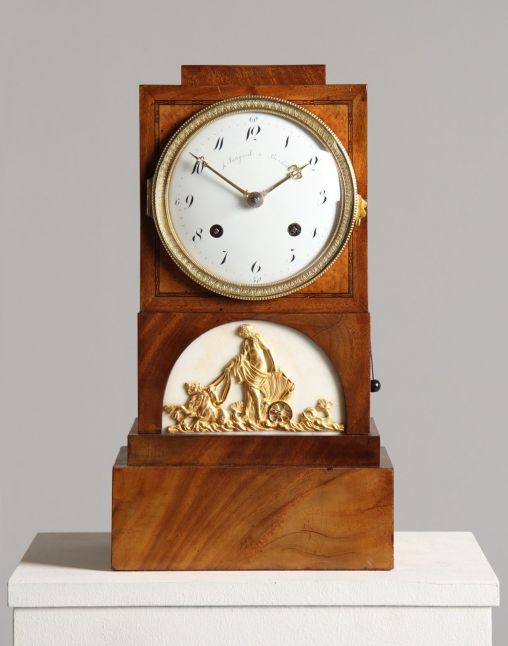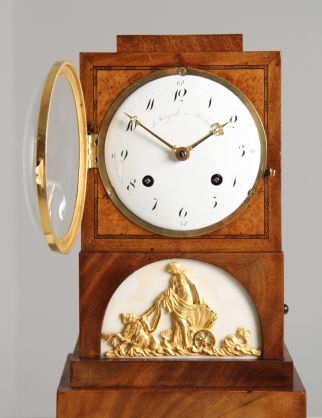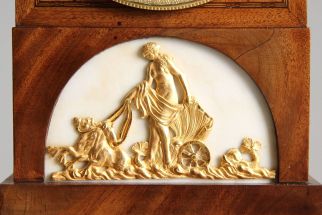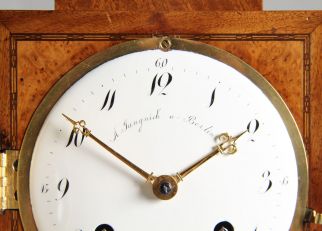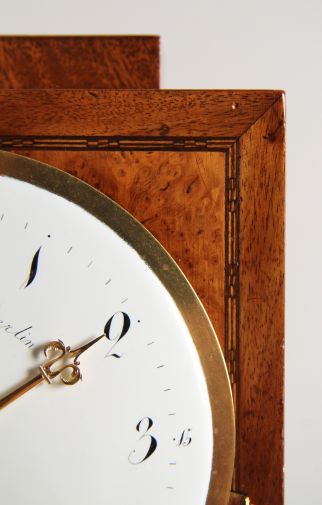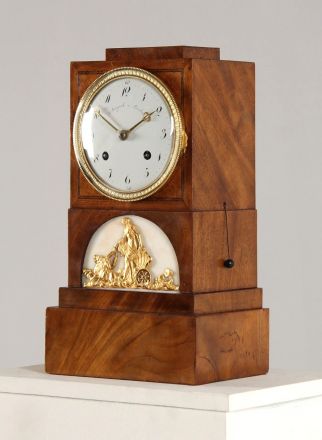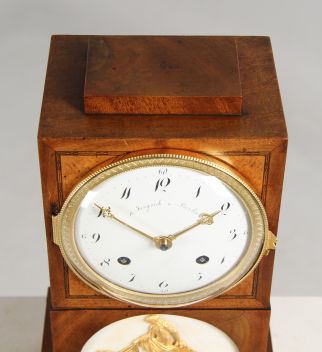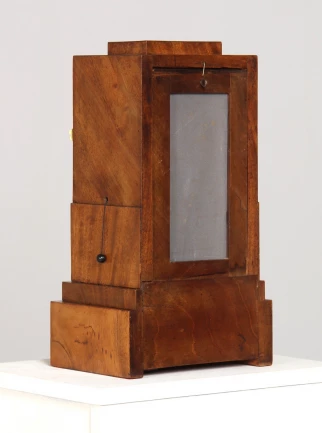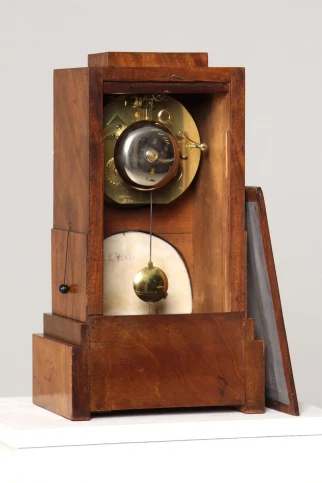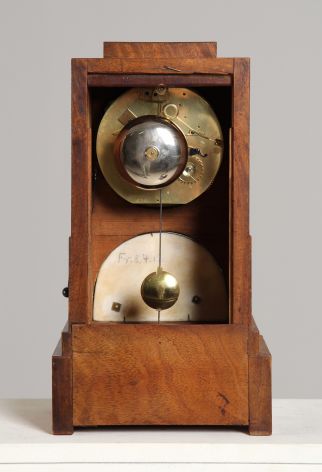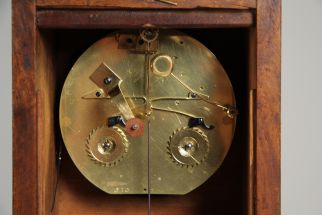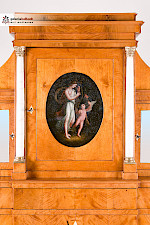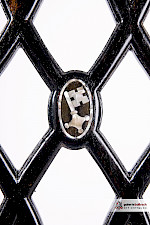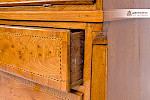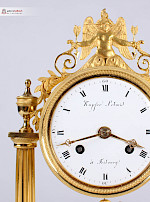Classicist Berlin clock
Berlin
Mahogany a.o.
circa 1820
Dimensions: H x W x D: 34 x 19 x 14 cm
Description:
Exceptionally fine stele clock from the Berlin late classicism of the early 19th century.
Typical of Berlin woodwork from this period is the staircase-like structure, here with a high base and a step that builds on it and continues the grain. Equally typical is the arched segmentation above, here inlaid with alabaster, which forms the background for the excellent bas-relief in fire-gilt bronze.
The figurative depiction shows the sea nymph Thetis, the mother of Achilles, on a shell chariot pulled by hippocampi. Her beauty concealed only by a light cloth, she stands on her floating vehicle, surrounded by mythical maritime creatures, travelling at full speed through the waves.
This work was probably modelled after a woodcut from the series of seven depictions of the gods by the German-Dutch artist Hendrick Goltzius (1558-1617) from the late 16th century, which shows Thetis in a shell chariot pulled by mythical sea creatures and which is now part of the collection of the Rijksmuseum in Amsterdam under object number RP-P-OB-10.477.
The upper part of the stele features fine mitred fillet bands that form a kind of frame for the white enamelled dial. Protected behind domed glass, we see neatly sawn brass hands, black Arabic numerals and the clockmaker's signature: A. Jungnick a Berlin.
The Francophile nature of the signature shows once again the great influence of French craftsmanship, especially clockmaking, on work of German or Prussian origin. The famous à Paris movements were known throughout Europe, the adaptation of this spelling was possibly also aimed at international sales.
According to Gerhard König - Uhren und Uhrmacherei in Berlin 1450-1900 p. 71, the Jungnick workshop can be traced to Spittelmarkt in Berlin around 1836. The Allgemeine Adreßbuch für Berlin aus dem Jahr 1820 by J. W. Boicke p.199 also lists A. Jungnick, a clockmaker by trade, with the address Spittelmarkt 1 in Berlin. Technically and stylistically, the clock can be dated to the earlier mention of the name.
The movement is a French-style pendulum movement with an 8-day running time and striking a bell on the half and full hour. On the right-hand side there is a striking train repeater with a ball on a thread. The back of the clock is covered with a thin cloth for better sound emission.
Condition:
The movement has been thoroughly cleaned and overhauled. It works perfectly. The case has been gently cleaned and preserved with all its patina and the naturally brightened colour of the mahogany wood. The glass pane in the centre has scratches that do not impair readability.
Please compare the following watchmaker and name directories:
Gerhard König - Uhren und Uhrmacherei in Berlin 1450-1900 p. 71
J. W. Boicke - Allgemeines Adreßbuch für Berlin aus dem Jahr 1820 p.199
Article found under: Clocks
Video Berlin clock
Also interesting
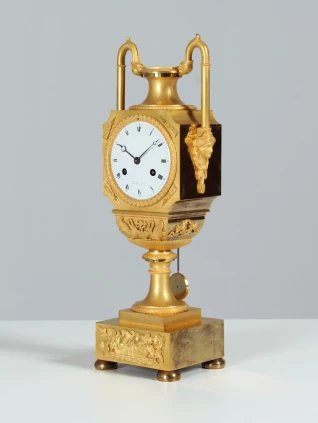
Antique Vase Clock
France
fire-gilt bronze
Empire around 1820
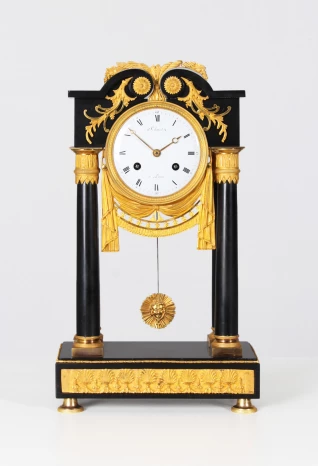
Antique Portal Clock
France
Marble, bronze, enamel
Directoire around 1800
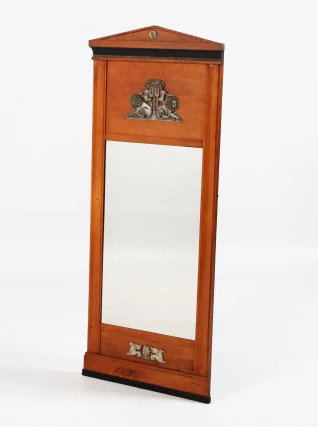
Biedermeier pillar mirror
Central Germany / Thuringia
Cherry
Biedermeier around 1825
